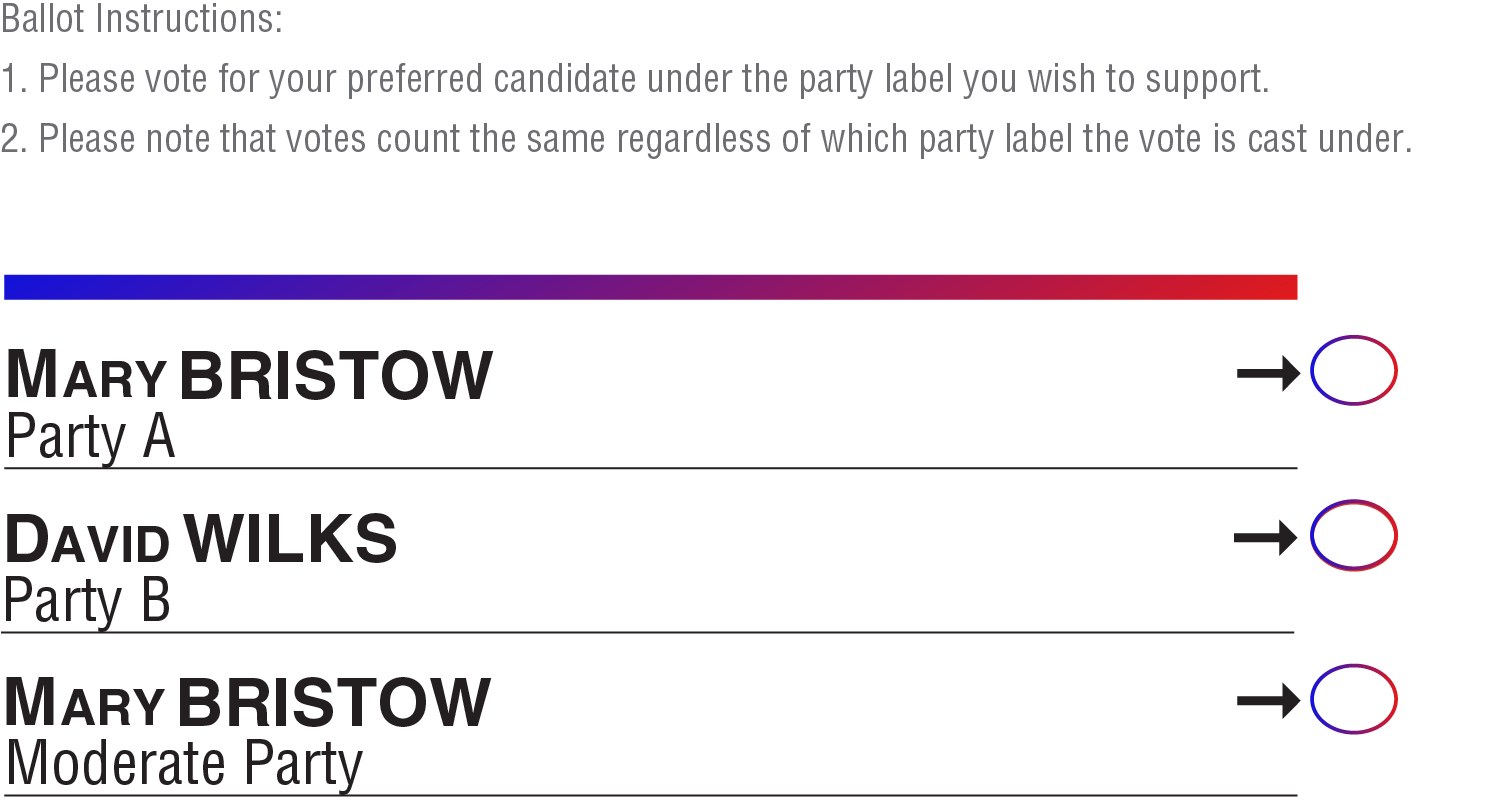Fusion 101
Fusion voting, once used in every state in the nation, is a practice in which a candidate can appear on the ballot as the nominee of more than one party. This easy-to-understand sample ballot shows how a new party “fuses” with a major party in support of the same candidate:
 Candidates nominated by major parties “A” and “B” are listed on the first two lines. On the third line, Bristow is listed for a second time, as the nominee for a new party (here, the “Fusion Party”). In a close race, the votes on the Fusion Party line could make the difference between a win and a loss for Bristow. Under fusion voting, new parties can become meaningful players, as candidates and major parties look to appeal to new party voters and hope to secure new party endorsements in the future.
Candidates nominated by major parties “A” and “B” are listed on the first two lines. On the third line, Bristow is listed for a second time, as the nominee for a new party (here, the “Fusion Party”). In a close race, the votes on the Fusion Party line could make the difference between a win and a loss for Bristow. Under fusion voting, new parties can become meaningful players, as candidates and major parties look to appeal to new party voters and hope to secure new party endorsements in the future.
Reinstating fusion voting is a common sense solution to counter the extremism and polarization ingrained in our political system. Fusion voting benefits:
- Voters: Fusion voting gives voters the ability to vote for a major party candidate on a party line that best matches their values. “Vote for the candidate you prefer under the party label closest to your values” is the traditional pitch of organizers in a fusion-legal regime. The voter neither “wastes” their vote on a new party candidate who has no chance of winning, nor “spoils” the election by unintentionally helping their less preferred major party candidate. Fusion also allows voters to vote for a major party candidate they like, without having to signal support for a major party they don’t support.
- New Parties: Fusion voting gives new parties more influence over the political agenda by forcing major party candidates to appeal to the voters represented by that new party.
- Candidates: Fusion voting produces more votes for major party candidates who appeal to multiple constituencies and are thus able to secure additional party endorsements.
Why Can’t the Two Major Parties Fix Our Democracy Under the Current System?
Parties are critical to a functioning democracy. Most people can’t research every candidate; parties help individuals vote efficiently and engage in politics. But the two major parties are trapped in an ever-escalating hyper-partisan cycle that rewards polarization and punishes compromise. Primaries, gerrymandering, geographic self-sorting, and news and social media bubbles keep us locked in partisan warfare. The system won’t self-correct by exhorting politicians to be more reasonable or to listen to the other side. Change will only come if the rules are structurally altered to incentivize cooperation and compromise.
Fusion voting would help change those rules and incentives. In this era of political extremes, fusion would serve as a moderating force; as this reform enables new parties to play a constructive role in our politics, more parties are incentivized to emerge, including those that represent the political center.
Imagine a “center” party that does not run its own slate of candidates, but like all fusion parties reviews the records of the two major party candidates and nominates the one with the clearest commitment to cross-partisan cooperation, problem solving, and the rule of law. It wouldn’t take long for the nomination of this center party to be an important, even decisive, factor in many elections. This, in turn, could encourage more compromise and productivity in policy making as the major parties compete for those voters. Ultimately, fusion voting would enable parties representing a range of viewpoints to emerge, as is the case in most healthy democracies. More parties would enrich the political discourse and move us beyond just red versus blue. For example, in Connecticut and New York, fusion voting has produced durable and constructive smaller parties, like the Conservative Party on the right and Working Families Party on the left.
Click below for additional resources:
- Fusion voting 2-pager
- How Fusion Works
- Free Speech on the Ballot: The Case for Fusion by Andy Craig, Rainey Center, November 2023
- The First Amendment and Fusion Voting by Andy Craig, Cato Institute, September 26, 2022
- More than Semantics: Distinguishing Dual Labeling from Traditional Fusion Voting by Joel Rogers and Maresa Strano, Ballot Access News, September 2023
- Fusion Voting: An Analysis by Myriah Pahl, Demos, March 2007
- More Choices, More Voices: A Primer on Fusion by J.J. Gass & Adam Morse, Brennan Center for Justice, October 2006
- Protect Democracy: Fusion voting, explained
